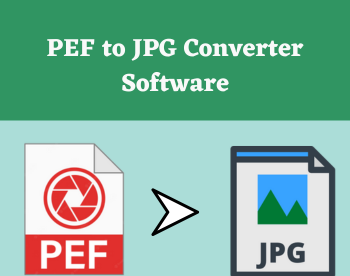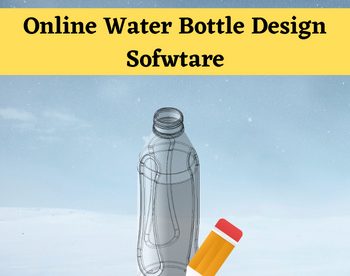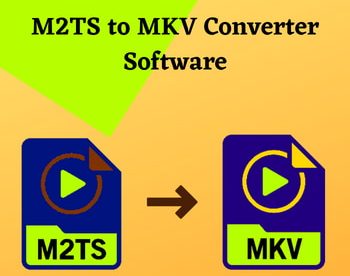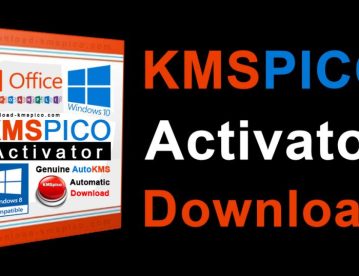6 Best Free PDB to PDF Converter Software for Windows
This article contains a list of best free PDB to PDF converter software for Windows. Using these free software, you can convert the molecular structure stored in a Protein Data Bank (PDB) file to Portable Document Format (PDF). Basically, you can save the view of a molecular structure in a printable form like PDF. For doing so, you can even customize the molecular view by setting up various display parameters, such as view style (Wireframe, Backbone, Sticks, Spacefill, Balls & Stick, Ribbons, etc.), color scheme, show or hide labels, molecular view (atoms, hydrogen, etc.), etc. You can also rotate or zoom the molecular structure and then convert the view to PDF format.
Many of these listed software are molecular modeling software. Hence, you can modify the structure using available molecule building tools like add atoms, add hydrogen, add chemical structures, etc. Plus, these are quite good at molecule visualization as they provide a good set of viewing tools like rotate, zoom, view mode, show labels, move, spin, etc. Furthermore, many of these also show statistics related to the molecular model and provide calculation and analysis tools.
Besides PDB, you can also convert other molecular files to PDF in most of these software. The most commonly supported input formats include MOL, MOL2, ENT, XYZ, and CML. As for output, you can convert PDB to various image formats like PNG, BMP, JPG, PS, EPS, etc. Go through the article to know more about these software.
My Favorite Free PDB to PDF Converter Software for Windows:
Avogadro is my favorite PDB to PDF converter software on this list as it is an advanced software which is good at molecule visualization and modeling too. It is also nicely designed with some additional tools related to molecular modeling.
Molekel is another good one which you can try to convert PDB to PDF.
You may also like some best free PDB Viewer Software, Molecular Modeling Software, and Chemistry Simulation Software for Windows.
Avogadro
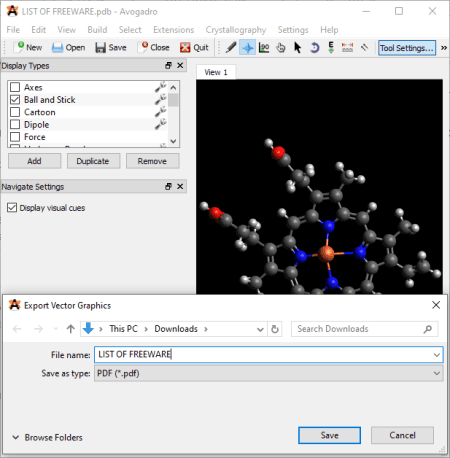
Avogadro is one of the most popular free open source molecular modeling software for Windows, Linux, and Mac. It can also be used to convert PDB to PDF as it provides a dedicated feature for that. You can also use it to convert PDB to other formats including PNG, BMP, JPG, SVG, EPS, POV, VRML, etc.
Generally, this software is used for molecule visualization, building, and editing. For doing so, it contains a feature-rich set of tools which can be used. Some of its tools include Perspective or Orthogonal projection, Fullscreen Mode, Add Hydrogens, Insert (Fragment, DNA/RNA, SMILES, and Peptide), Super Cell Builder, Nanotube Builder, Change H to Methyl, Cartesian Editor, etc.
How to convert PDB to PDF in Avogadro:
- Using its open feature, import a PDB file to this software.
- Edit the molecular model with available tools, if required.
- Now, go to its File menu and click on the Export > Vector Graphics option and select PDF as the output format to save the molecular view in PDF format.
Before PDB to PDF conversion, you can customize display settings to export a personalized view of molecules to a PDF or graphic file. These display settings include show/ hide axes, force, dipole, polygon, ring, stick, surfaces, wireframe, etc.
Additional Features:
- It contains various extensions which further enhances its functionality such as Optimize Geometry, Calculate Energy, Conformer Search, GLSL Shaders, etc.
- Besides PDB, it supports various input file formats like CML, XYZ, MOL, MOL2, ENT, GAMOUT, etc.
Conclusion:
It is a great free open source PDB to PDF converter software which provides good quality output. You can also modify the PDB file before starting the conversion to PDF or any graphics format.
Molekel
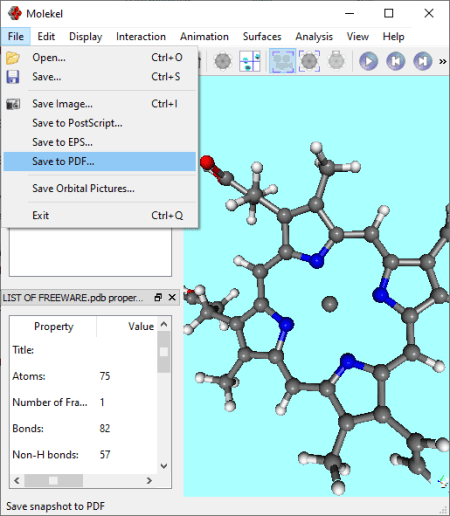
Molekel is a free molecule file viewer software which can also be used to convert PDB to PDF. It provides a direct option to convert PDB files to PDF format. So, you can easily import a PDB structure file and then save it in a PDF file. Also, you can convert other molecular files to PDF as it supports a wide number of input formats including XYZ, YOB, ALC, SDF, SMI, RXN, PCM, PQS, MOL, MOL2, TMOL, etc.
How to convert PDB to PDF in Molekel:
- Simply open a PDB file in it which you can properly view and analyze using its advanced viewing tools.
- Now, from its File menu, click on the Save to PDF option in order to convert PDB to PDF.
Additional Features:
- You can customize various display setting before converting the PDB structure to PDF, such as background, molecule view (ball & stick, stick, wireframe, etc.), atom, bond, 3D view properties, etc.
- It lets you record molecular animation and export it.
- It provides some analysis features including plane probe, distance, angle, dihedral angle, and radiation spectrum.
- You can convert PDB and other molecular structure files to PS, EPS, PNG, and TIFF images.
- You can also view basic molecular model properties and statistics related to atoms, bonds, energy, residues, conformers, molar mass, exact mass, spin multiplicity, vibration frequencies, etc.
Conclusion:
It is a good PDB to PDF converter which provides some advanced molecular visualization tools too.
RasMol
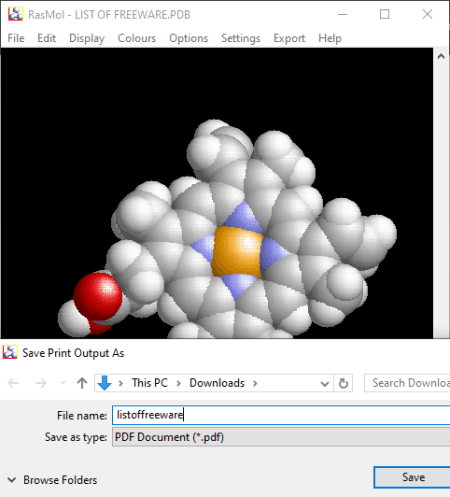
RasMol is another free PDB to PDF converter software for Windows. It is a nice molecular file viewer which you can also use to convert PDB or another supported input file to several other formats. These formats include BMP, GIF, IRIS RGB, PPM, Sun Raster, PostScript, POVRay, VRML, Raster3D, etc. However, to convert PDB to PDF, you will have to use its Print feature. Let’s checkout the sorted steps which you need to perform to convert a molecular structure saved in PDB file to PDF.
How to convert PDB to PDF in RasMol:
- Import a PDB file in it using the Open option.
- After that, you can set up the display of molecular structure using available options such as view mode (wireframe, backbone, sticks, ball & sticks, ribbons, strands, etc.), colors (monochrome, chain, temperature, enable or disable options like slab modes, hydrogens, hetero atoms, labels, stereo, etc., and more.
- You can now use its print feature to convert the customized view of PDB molecular structure to PDF format.
Conclusion:
It is another good PDB to PDF converter software as you can also convert PDB to several other graphical formats as mentioned above. Plus, it supports many other file formats as input other than PDB, like Alchemy File Format, Sybyl MOL2 Format, MDL Mol File Format, CIF File Format, MOPAC File Format, etc.
ArgusLab

ArgusLab is a free molecular building software which you can use to convert PDB to PDF. Using it, you can easily import and view molecular data files such as PDB, XYZ, MOL, MOL2, etc., as well as convert these files to other formats including PDF, TIFF, BMP, JPG, and POV. As it lets you build molecular models, you can also edit a PDB file before conversion.
How to convert PDB to PDF using ArgusLab:
- At first, open a PDB file in it which you will be able to view on its interface.
- Now, if required, you can modify the molecular model using tools like translate mode, add atoms, add hydrogens, delete hydrogen, create and edit surfaces, etc.
- Next, to save the view of the PDB model in PDF format, click on its File menu > Print option and select “Microsoft Print to PDF” as the printer. This way, you will be able to convert PDF to PDF.
Additional Features:
- It lets you explore different elements of a PDB or any other molecular file such as Atoms, Residues, Groups, etc.
- It lets you perform various calculations related to molecular model such as energy, optimize geometry, Gaussian, etc.
Conclusion:
It is a featured molecule building software which also acts as a PDB to PDF converter.
Jmol

Jmol is another free open source PDB to PDF converter software for Windows. It is a nice molecule modeler software using which you can view, edit, and build molecular files. Besides PDB, it works with some other formats like MOL, MOL2, XYZ, CML, ENT, and many more unusual molecule file formats.
How to convert PDB to PDF using this free open source molecular modeler:
- Firstly, go to the File menu and use the Open option to import a PDB file in it.
- Now, you can edit the molecular structure using available modeling tools.
- After that, use its Print feature in order to convert PDB to PDF format. While doing so, make sure you have set printer to Microsoft Print to PDF.
Additional Features:
- It contains some additional tools which you can use as per your requirements such as Animate, Measurements, Vibrate, Surface Tool, Create Gaussian Input File, etc.
Conclusion:
It is a nice portable PDB to PDF converter which requires no installation. You can directly use it on the go from any portable storage device.
BALLView

BALLView is one more free open source PDB to PDF converter software on this list. Like other listed software, it also lets you import a PDB file and then print the view of molecular structure in PDF format. Apart from PDF, you can also use it to convert PDB to other formats including PNG, POV, XHTML, VRML, and STL.
Apart from PDB, it supports some other chemical file formats which you can view, edit, or convert. These input formats include MOL, MOL2, XYZ, ENT, AC, SD, etc.
How to convert PDB to PDF using BALLView:
- The first step is to import a PDB file using its File > Open > Structure option.
- Next, use its Print option and select Microsoft Print to PDF as printer to convert PDB to PDF.
Conclusion:
It is another decent alternative to convert a Protein Data Bank file to PDF format.
About Us
We are the team behind some of the most popular tech blogs, like: I LoveFree Software and Windows 8 Freeware.
More About UsArchives
- May 2024
- April 2024
- March 2024
- February 2024
- January 2024
- December 2023
- November 2023
- October 2023
- September 2023
- August 2023
- July 2023
- June 2023
- May 2023
- April 2023
- March 2023
- February 2023
- January 2023
- December 2022
- November 2022
- October 2022
- September 2022
- August 2022
- July 2022
- June 2022
- May 2022
- April 2022
- March 2022
- February 2022
- January 2022
- December 2021
- November 2021
- October 2021
- September 2021
- August 2021
- July 2021
- June 2021
- May 2021
- April 2021
- March 2021
- February 2021
- January 2021
- December 2020
- November 2020
- October 2020
- September 2020
- August 2020
- July 2020
- June 2020
- May 2020
- April 2020
- March 2020
- February 2020
- January 2020
- December 2019
- November 2019
- October 2019
- September 2019
- August 2019
- July 2019
- June 2019
- May 2019
- April 2019
- March 2019
- February 2019
- January 2019
- December 2018
- November 2018
- October 2018
- September 2018
- August 2018
- July 2018
- June 2018
- May 2018
- April 2018
- March 2018
- February 2018
- January 2018
- December 2017
- November 2017
- October 2017
- September 2017
- August 2017
- July 2017
- June 2017
- May 2017
- April 2017
- March 2017
- February 2017
- January 2017
- December 2016
- November 2016
- October 2016
- September 2016
- August 2016
- July 2016
- June 2016
- May 2016
- April 2016
- March 2016
- February 2016
- January 2016
- December 2015
- November 2015
- October 2015
- September 2015
- August 2015
- July 2015
- June 2015
- May 2015
- April 2015
- March 2015
- February 2015
- January 2015
- December 2014
- November 2014
- October 2014
- September 2014
- August 2014
- July 2014
- June 2014
- May 2014
- April 2014
- March 2014
